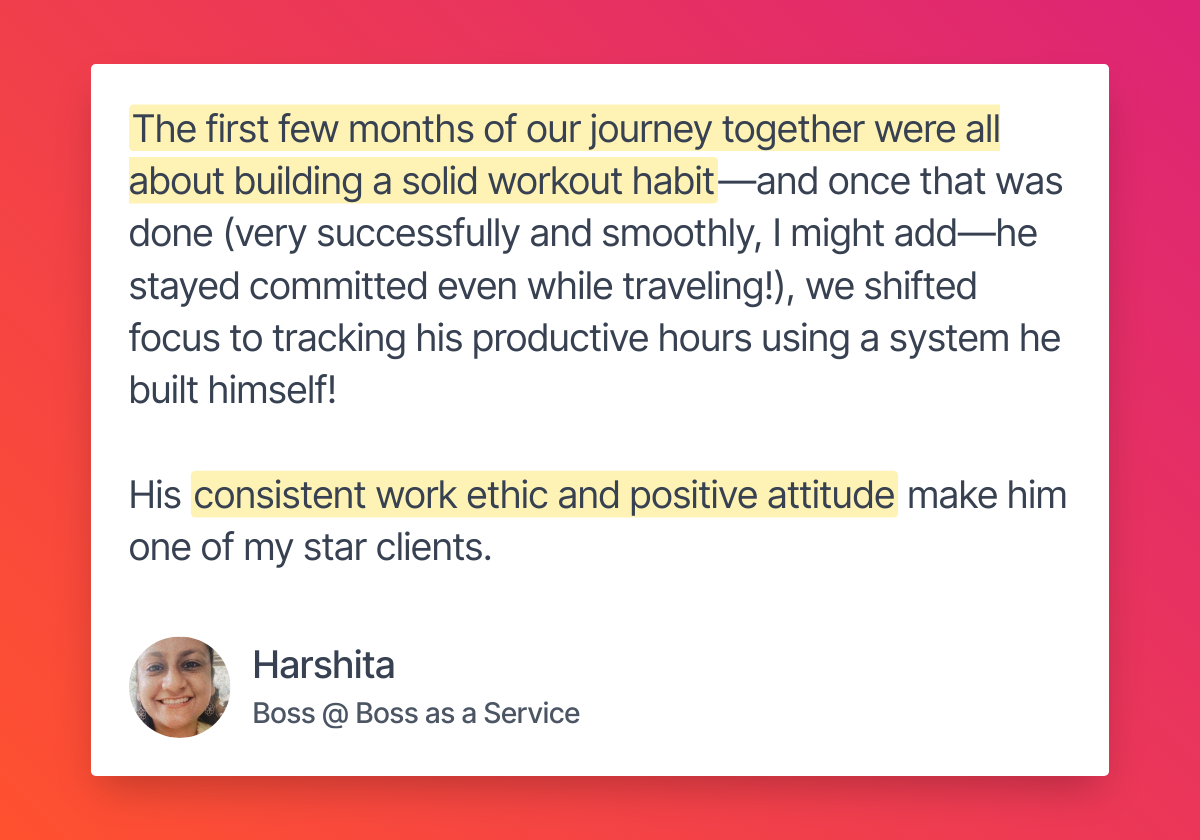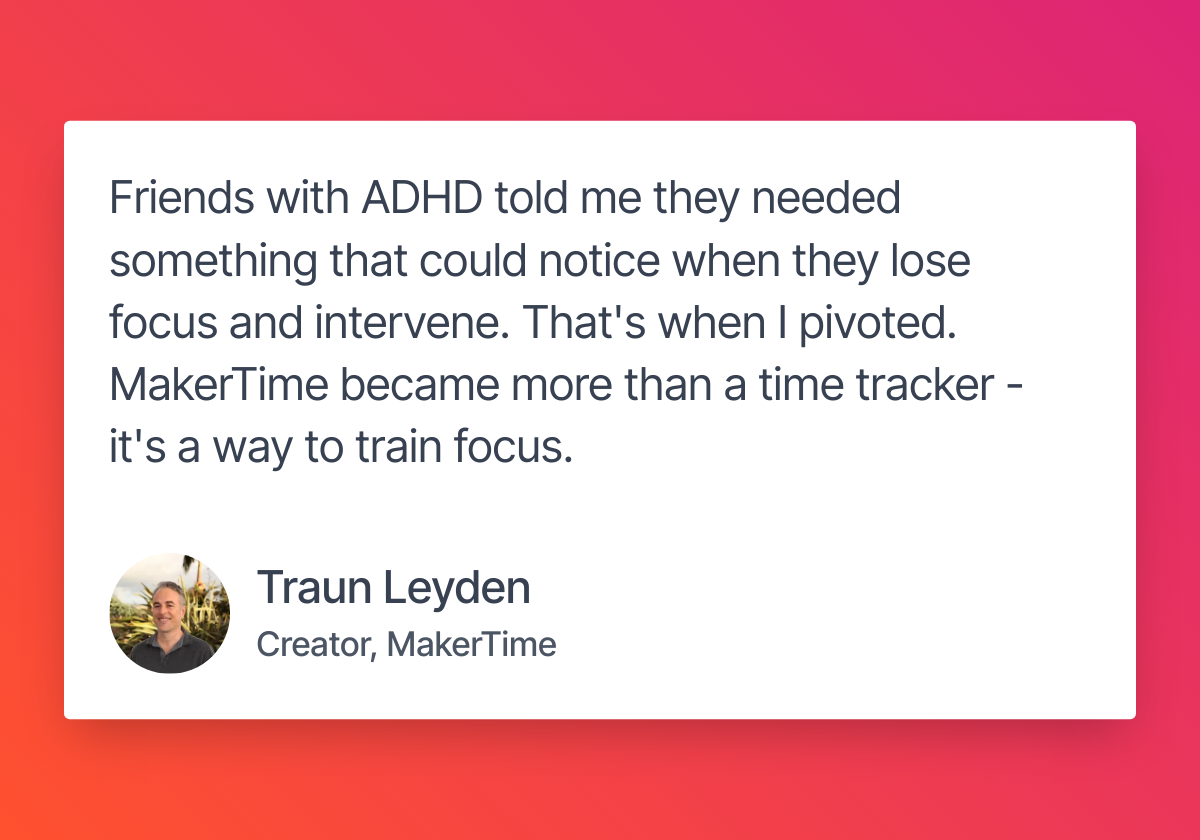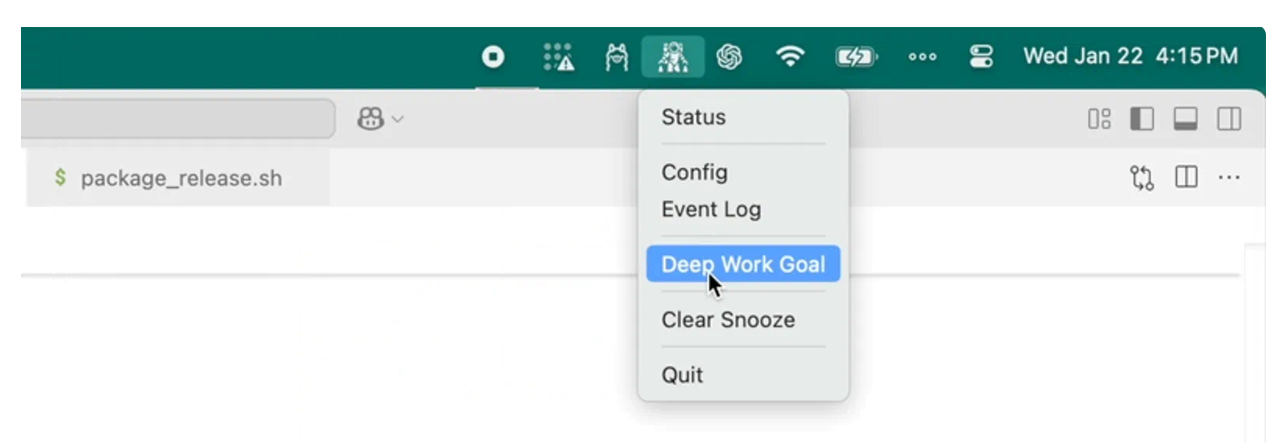Building Focus: How Traun Leyden Created MakerTime, an AI for Deep Work
Traun Leyden, creator of MakerTime and BaaS user, shares how he built an AI-powered focus tracker, stayed accountable as a solo founder, and turned distraction into data-driven deep work.
Traun Leyden is a Boss as a Service user and the creator of MakerTime, an AI-powered focus tracker. When Traun couldn’t find a time tracker that understood his focus habits, he built one, with AI. In this Q&A, we talk about how he built MakerTime, what it’s like designing for deep work, and how Boss as a Service kept him accountable through it all.
Tell us a little bit about yourself!
I'm Traun, an American digital nomad currently living in Munich, Germany. I spent most of my career in the Bay Area as a senior software engineer for startups and scale-ups like Couchbase and Databricks. Recently, I’ve shifted gears to become a solopreneur building Mac and iOS apps, the latest of which is MakerTime.
What brought you to Boss as a Service?
It started with fitness. I had been using a service that paired me with a fitness coach who’d guide my fitness journey, but it was a bit too expensive to maintain. So I cancelled it and eventually stopped working out after a few weeks.
Months later, I wanted to get back on track, but I realized that fitness apps weren’t doing the trick – even though they had reminders and tracking features, I’d just ignore them. I benefited most from just having a human accountability coach: if a real person is holding me accountable, I would not want to disappoint them.
I thought about asking friends or random people on the internet, but stumbled upon recommendations for BaaS while searching through Google and Reddit. So I signed up!
How has your BaaS experience been so far?
It's been awesome! So far, I’ve focused on my fitness journey, and sending screenshots of my daily workouts is quite easy. My Boss (Harshita) is super supportive and friendly. She also runs a tight ship and has always called me out when I miss a workout.

Tell us about MakerTime. What is it, and why did you build it?
Here's the quick version of the origin story: I started my career with several back-to-back full-time software engineering jobs and never had to think about tracking my hours. But then I moved to freelance contract work part-time, where I had to carefully track the time I spent. I didn't want to use start-and-stop timers, so I built something to do it for me.
When I showed the prototype to my network, a few friends with ADHD told me they desperately needed something to track their focus. They wanted something that would intervene as soon as they lost focus. I realized I would love to see metrics to quantify my own deep work patterns, and it seemed like a more important problem, so I pivoted, and we now have MakerTime.

How is MakerTime different from other time-tracking tools?
MakerTime is different from other screen time tracking apps like RescueTime or Rize, which I’ve also tried, because the AI-powered language learning model (LLM) and vision language model provide more accurate readings of what you’re doing. In other words, they provide context.

Say you’re at work and using Slack to chat with your peers. If you’ve told any other tracker that Slack is a “distracting” website, it will automatically assume you’re being unproductive. But what if you’re talking about work or fixing a problem?
You need to determine if you are really focusing when you need to or being unproductive. So you install MakerTime, and it runs in the background. Every 45 seconds, the app checks whether you’re active. If yes, it takes a screenshot of your current window and then analyzes what you’re doing.
If you’re just scrolling through social media or doing something that doesn’t fit into your work context, the app sends you a “distraction detection” alert. But if it sees that you’re following the rules and you reach your daily deep work goal, you get a virtual pat on the back!

Was it hard to stay consistent while building such a complex tool?
If you consider all the features I want to build into MakerTime, it would have been a very daunting project indeed, especially for a solo entrepreneur. But I didn't have any issues making consistent progress for one big reason: I was so curious to see if it was going to actually work! I prototyped a bit before writing any code, which showed early promise. But I was still very anxious to see it run and accurately track my deep work throughout the day.
There were some roadblocks, though. When I showed early versions to beta users, I didn't quite get the reaction I was hoping for. They would ask me the tough questions, and I would realize that I had a ton more work to do. But it was also motivating that I had a new challenge to tackle that would get me closer to a product fit for the market.
Any advice for fellow builders or creatives in the BaaS community?
If you are building something for yourself (like I was), you should reach out to your network to track down as many potential customers as you can. They might have very different ideas of what a great product looks like. The earlier you can do this, the better. I'd recommend doing "The Mom Test" style user interview (The Mom Test is a book that provides a strategy to get factual and objective feedback on your ideas, even from those who may be prone to lying to you because they love you!) to gather as much unbiased data as possible, then pitch them your product idea to get their feedback.
When you interview users, ask them open-ended questions, like "Do you have any suggestions or ideas?". I found that when I asked that, I got some amazing feedback.
What’s next for you and MakerTime?
I’m still collecting user feedback to decide the next big features. As a user myself, I know there is a ton of rich data being captured by MakerTime that isn't being shown in the UI yet. For example, I want to see my weekly and monthly streaks.
One prospective user told me: "I want it (the tracker) to analyze what I was doing right before I started getting distracted on social media, so that I could find common patterns and address them." I haven't implemented that feature yet, but it sounds really cool and I want that too!
I also want to address the privacy concerns. Many prospective users ask if their data is safe, which I totally understand because I have the same doubts about other apps that do background screen capture. I have built MakerTime so that with the default configuration, no data screen captures are permanently saved, nor does any data ever leave your computer. But I am looking for ways to give users more peace of mind – and I’m totally open to suggestions!
MakerTime’s in free alpha right now. Try it, break it, and tell me what you’d change — I’m all ears.
Looking for more articles?